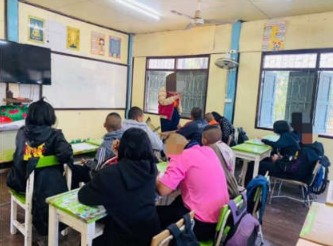A Study of Learning Achievement and Mathematical Skills and Processes of Grade 6 Students Using Cognitively Guided Instruction and Badham’s Questioning Techniques
Main Article Content
Abstract
This research was aimed to 1) compare grade 6 students’ learning achievement using cognitively guided instruction and Badham’s questioning techniques between before and after learning and the 70 percent criterion 2) compare grade 6 students’ mathematical skill and process before and after learning management. compare grade 6 students’ mathematical skill and process after learning management using cognitively guided instruction and Badham’s questioning techniques after learning and the 70 percent criterion. The sample group for this research was 13 students of grade 6 students in the 2nd semester, academic year of 2020 at Wadkoksranoi school. The sample was selected using a cluster random sampling. The research instruments consisted of lesson plans with the appropriate value of 4.67, the achievement test with the IOC of 0.67-1.00 and the reliability of 0.96 and the mathematical skill and a process measurement with the IOC of 1.00 and the reliability of 0.83 The data were statistically analyzed by the Kolmogorov-Smirnov test, percentage, mean, standard deviation of items and independent t-test. The research findings showed that 1) learning achievement of students on a learning unit after higher than before learning and higher than 70% criterion at 0.05 level 2) Mathematical skill and process after learning management was significantly higher than the designated criterion of 70 percent at the .05 level.
Article Details

This work is licensed under a Creative Commons Attribution-NonCommercial-NoDerivatives 4.0 International License.
References
กุลวดี อำภาวงษ์. (2560). ผลการจัดกิจกรรมการเรียนรู้แบบการสอนแนะให้รู้คิด (CGI) เรื่อง ความสัมพันธ์ระหว่างเรขาคณิต สองมิติและสามมิติ ที่มีผลต่อผลสัมฤทธิ์ทางการเรียนและความสามารถในการให้เหตุผลทางคณิตศาสตร์ของนักเรียนชั้นมัธยมศึกษาปีที่ 1 (วิทยานิพนธ์มหาบัณฑิต, มหาวิทยาลัยบูรพา).
กิติพงษ์ ลือนาม. (2561). วิธีวิทยการวิจัยทางการศึกษา. นครราชสีมา: โรงพิมพ์ ห้างหุ้นส่วน จำกัด โคราช มาร์เก็ตติ้ง แอนด์โปรดักชั่น.
ชุติมา ฉุนอิ่ม. (2558). การพัฒนาการคิดเชิงคณิตศาสตร์ของนักเรียนชั้นมัธยมศึกษาปีที่ 1 โดยใช้กิจกรรมการเรียนรู้แบบการสอนแนะให้รู้คิด (CGI) ร่วมกับเทคนิคการใช้คำถามของบาดแฮม (Badham) (ปริญญานิพนธ์มหาบัณฑิต, มหาวิทยาลัยนเรศวร).
ราชนก บรรหาร, สิรินาถ จงกลกลาง และอิสรา พลนงค์. (2564). การศึกษาผลสัมฤทธิ์ทางการเรียนและความสามารถในการแก้ปัญหาทางคณิตศาสตร์หน่วยการเรียนรู้เรื่องการหารของนักเรียนชั้นประถมศึกษาปีที่ 2 โดยใช้การจัดการเรียน รู้แบบกระบวนการแก้ปัญหาร่วมกับบาร์โมเดล. วารสารราชพฤกษ์. 19(1), น. 99-108.
โรงเรียนวัดโคกสระน้อย. (2563). หลักสูตรสถานศึกษากลุ่มสาระการเรียนรู้คณิตศาสตร์ โรงเรียนวัดโคกสระน้อย.นครราชสีมา: โรงเรียนวัดโคกสระน้อย
สถาบันส่งเสริมการสอนวิทยาศาสตร์และเทคโนโลยี. (2555). ครูคณิตศาสตร์มืออาชีพเส้นทางสู่ความสำเร็จ. กรุงเทพฯ: 3-คิว มีเดีย.
สถาบันส่งเสริมการสอนวิทยาศาสตร์และเทคโนโลยี. (2560). คู่มือการใช้หลักสูตรกลุ่มสาระการเรียนรู้คณิตศาสตร์ (ฉบับปรับปรุง พ.ศ. 2560). กรุงเทพฯ: กระทรวงศึกษาธิการ.
สมบูรณ์ ตันยะ. (2556). วิธีวิจัยทางการศึกษา. นครราชสีมา: มหาวิทยาลัยราชภัฏนครราชสีมา.
สำนักงานคณะกรรมการการศึกษาขั้นพื้นฐาน. (2551). ตัวชี้วัดและสาระการเรียนรู้คณิตศาสตร์ตามหลักสูตรแกนกลางการศึกษาขั้นพื้นฐาน พุทธศักราช 2551. กรุงเทพฯ: โรงพิมพ์ชุมชนการเกษตรแห่งประเทศไทย.
สุดารัตน์ พันหา และสิรินาถ จงกลกลาง. (2563). การศึกษาผลสัมฤทธิ์ทางการเรียน หน่วยการเรียนรู้การบวก การลบ การคูณการหารเศษส่วน และพฤติกรรมการทำงานกลุ่ม ของนักเรียนชั้นประถมศึกษาปีที่ 6 จากการจัดการเรียนรู้แบบร่วมมือ. วารสารราชพฤกษ์.18(1), น.110-118.
อัมพร ม้าคนอง. (2553). ทักษะและกระบวนการทางคณิตศาสตร์. กรุงเทพฯ: โรงพิมพ์แห่งจุฬาลงกรณ์มหาวิทยาลัย.
Carpenter, T.P. et al. (1999). Children’s mathematics: Cognitively guided instruction. Portsmouth, NH: Heinemann.
Carpenter, T.P. et al. (2000). Cognitively guided instruction: A research-based teacher professional development program for elementary school mathematics. National Center for Improving Student Learning and Achievement in Mathematics and Science.
Schielack, J.F. (2000). Designing questions to encourage children’s mathematical thinking. Teaching Children Mathematics, 6(6), pp. 398-402.
Way, J. (2014). Using questioning to stimulate mathematical thinking. Australien Primary Mathematics Classroom, 13(3), pp. 22- 27.

